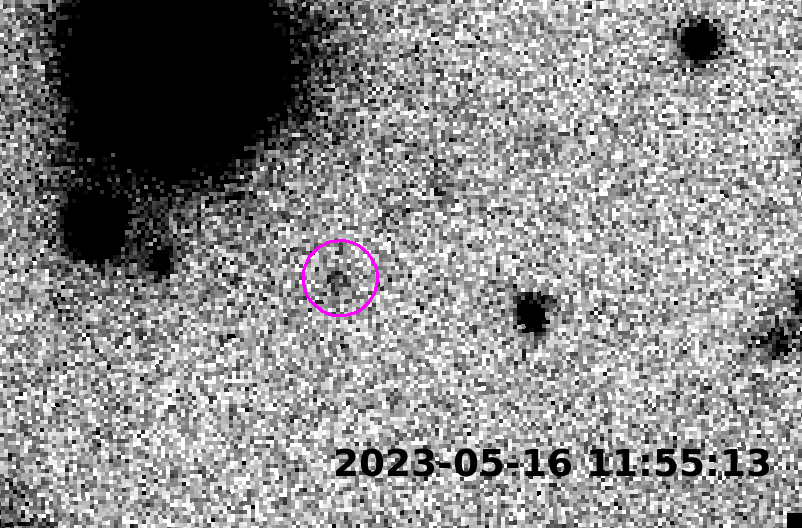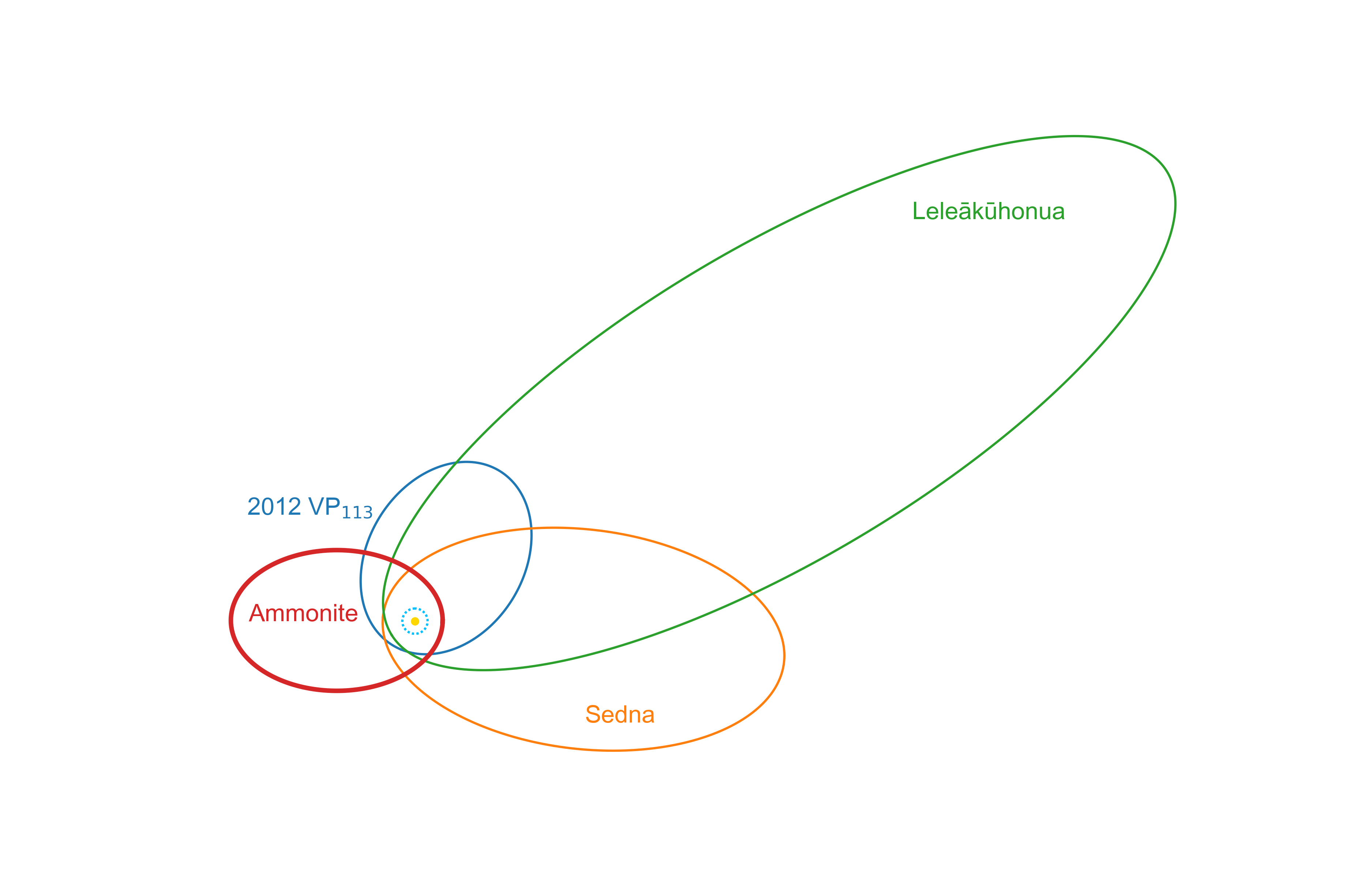Astronomy enthusiasts have been diligently searching for the Solar System’s “Planet Nine.” Is there finally a glimmer of hope? An international project led by Dr. Shiang-Yu Wang and Dr. Ying-Tung Chen from the Institute of Astronomy and Astrophysics, Academia Sinica (ASIAA), has discovered a distant Solar System object, 2023 KQ14, nicknamed “Ammonite,” using the Subaru Telescope in Hawaii. Ammonite follows a stable orbit with a perihelion distance of 66 astronomical units (au), placing it in the extremely rare category of “Sedna-like objects” (also known as Sednoids), whose orbits lie far beyond the gravitational influence of Neptune. Notably, Ammonite shows a markedly different orbital orientation from known Sedna-like objects in the Solar System. This surprising contrast sheds light on the complexity and evolutionary history of this distant population, and may reduce the likelihood that Planet Nine exists. The discovery was published on July 14, 2025 in Nature Astronomy.
The defining feature of Sedna-like objects is their perihelion—the closest point to the Sun in their orbits—lying far beyond Neptune’s orbit (approximately 30 au). Previously, the only known objects staying this far from the Sun were Sedna (perihelion ~76 au), 2012 VP₁₁₃ (perihelion ~80 au), and Leleakuhonua (perihelion ~65 au). Their unusual trajectories hint at hidden forces in the Solar System—possibly a long-lost planet, a stellar encounter billions of years ago, or the presence of an undiscovered planet, sometimes referred to as Planet Nine.
Dr. Ying-Tung Chen, the first author of the study and a Support Scientist in ASIAA, pointed out that Ammonite is the fourth discovered Sedna-like object. What makes Ammonite particularly noteworthy is its position in orbital parameter space: it lies within a previously nearly empty region with perihelion distances between 50 and 75 au and semi-major axes between 180 and 600 au. For years, astronomers debated whether this gap was due to observational limitations or a true dynamical feature shaped by unseen gravitational influences. With advances in telescopes and sky surveys, scientists can now detect objects in this once-overlooked region.
Dr. Chen emphasized that while previously known Sedna-like objects all share roughly similar orbital orientations, Ammonite’s orbit is oriented in the opposite direction. Ammonite’s unique orbit suggests that the outer Solar System is more diverse and complex than previous perceptions. If the Planet Nine scenario is true and such a planet exists, then the reason Ammonite's orbit does not cluster with that of the other members will need to be investigated. The existence of Ammonite also limits the possible orbital parameters of Planet Nine. "Finding Ammonite is like discovering a missing piece of the puzzle at the Solar System’s frontier," said Dr. Chen. “It expands our understanding of the orbital distribution of extremely distant trans-Neptunian objects.”
“The significance of discovering Ammonite goes far beyond adding one more distant object,” said Dr. Shiang-Yu Wang, the corresponding author and a Research Fellow in ASIAA. “Ammonite’s orbit tells us that something sculpted the outer Solar System very early on. Whether it was a passing star or a hidden planet, this discovery brings us closer to the truth.”
天文愛好者努力尋找太陽系的「第九行星」,是否終露一線曙光?由中央研究院天文及天文物理研究所王祥宇研究員與陳英同博士主導的國際研究計畫,利用位於夏威夷的昴望遠鏡(Subaru Telescope)觀測分析,發現了一顆遙遠的外太陽系天體——「2023 KQ14」,暱稱為「菊石」(Ammonite)。菊石擁有穩定的軌道,其近日點為66天文單位(au),屬於極稀有的「類賽德娜天體」(Sedna-like objects,亦稱Sednoid),軌道遠在海王星重力影響之外。值得注意的是,菊石的軌道方向,與太陽系中其他3顆類賽德娜天體相反,為此遙遠天體族群的複雜性與演化歷史提供新線索,也意味著第九行星存在的可能性降低。研究成果已於今(2025)年7月14日發表於國際期刊《自然天文學》(Nature Astronomy)。
類賽德娜天體最大特徵為近日點(軌道中離太陽最近的位置)距離海王星軌道(約30au)非常遙遠,此前已知的類賽德娜天體僅有3顆,即賽德娜(Sedna, 近日點76 au)、2012 VP₁₁₃(近日點80 au)與Leleakuhonua(近日點65 au)。此3顆天體的異常軌道暗示著太陽系中可能存在尚未發現的影響力量——也許是一顆早已消失的行星、或是數十億年前與其他恆星的掠遇,又或為目前仍未被發現的第九行星。
論文第一作者、中研院天文所支援科學家陳英同博士指出,菊石為第4顆被發現的類賽德娜天體,此發現的重要性,首先在於菊石處於一個過a
去觀測上幾乎空白的軌道參數區域(近日點介於50至75 au,軌道半長軸介於180至600 au之間)。多年來,天文學家爭論此區域的空缺究竟導因於觀測限制,或是受到未見的重力來源而確實不存在任何天體。但隨著菊石的發現,證實科學家可透過更先進的望遠鏡等巡天設備,開始有機會在這被忽略的區域中發現天體。
陳英同進一步指出,此前已知的類賽德娜天體軌道方向大致相同,但菊石的軌道卻朝另一方向。此一獨特特徵顯示外太陽系的動力結構比過去理解的更為多樣與複雜。若第九行星確實存在,就必須解釋為何菊石的軌道未與其他天體同一方向。菊石的存在,也對第九行星可能的軌道有了新的限縮。「發現菊石,就像在太陽系的邊界找到失落的一塊拼圖,拓展了人類對外太陽系極遠天體軌道分布的認識。」
論文通訊作者王祥宇研究員表示,發現菊石的意義遠不止於新增一顆遙遠天體。「菊石的軌道告訴我們,在太陽系形成之初,就有某種機制雕塑了外太陽系的樣貌。不論是掠過的恆星,還是隱藏的行星,這項發現讓我們離真相更近一步。」


